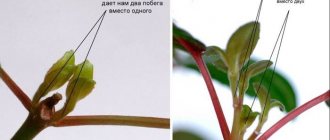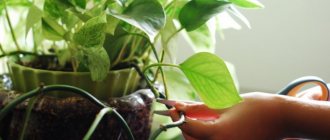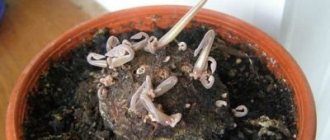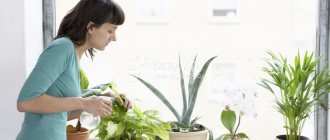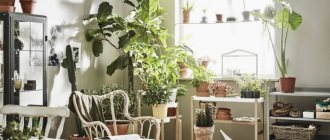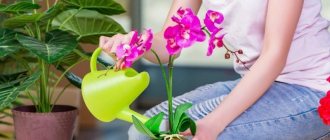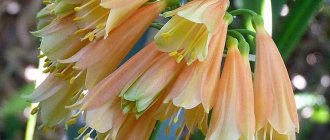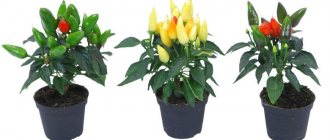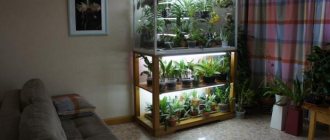Lianas - what do we know about this exotic plant, what characteristics does the plant have, is it possible to grow it at home and how to properly care for indoor lianas? We will try to answer these and other questions in this article.
10 Rules for Caring for Indoor Vines Sorry, there are no surveys available at this time.
Every day, growing exotic plants on your windowsill is gaining more and more popularity and liana is no exception. The homeland of lianas is considered to be tropical (about 2,000 varieties) and European forests, the Far East, the Caucasus, Crimea - where about 200 forms of the plant exist. They are herbaceous, evergreen or deciduous plants, perennial or annual, with herbaceous or woody stems, which reproduce rapidly by cuttings.
At home, it is customary to grow decorative indoor vines, of which there are many varieties. They fit perfectly into the home interior, rising up with ease and becoming not only a decoration for walls, but also stairs, supplies, columns, etc.
All varieties of vines, regardless of decorative or wild, have common characteristics, including the need for mandatory support, since they cannot stand on their own.
Before you get a tropical “pet” at home, learn all the intricacies of caring for it.
Flower growers prefer to grow climbing vines, since such a plant changes shape - it can be twisted, bent, or given a spiral shape. Most often, species such as ivy, monstera, hoya, bindweed, chlorophytum, clerodendron, passionflower and others are planted in indoor pots.
Whatever type of vine you choose, it requires careful and regular care; one mistake and the plant loses its appearance and attractiveness, growth slows down, and the leaves begin to wither. To avoid mistakes and grow a real beauty, you should follow the general rules for caring for indoor vines.
Individual approach
The choice of vines should be approached responsibly. To grow and maintain a presentable appearance of the plant, try to adhere to a special care program. The easiest way to monitor the condition of a flower is to hang a tag with general information (time of fertilizing, watering, replanting, humidity indicator) on the pot. This method will help to identify what the plant lacks.
The choice of vines should be approached responsibly
A distinctive feature of all decorative vines is high air humidity and diffused lighting. If the humidity in the room is low, the plant will lose leaves and there is a possibility of getting a bare stem, and if exposed to direct sunlight, the flower may get leaf burns. Considering these needs, determine a suitable location. Study all the characteristics and individual features, namely: pruning (it is individual for each subspecies), watering, replanting, fertilizing, and only with a complete understanding of the future decorative vine, buy it home.
Watering stages = development stages
The time of year and stage of growth certainly affects the need for watering indoor plants. For the liana family, a properly drawn up and timely adjusted watering schedule will help avoid withering and rotting of the plant.
For the liana family, a properly drawn up and timely adjusted watering schedule will help avoid wilting.
Water consumption depends on the period of active growth of the plant or its dormancy; the main thing is not to over-moisten the soil in order to avoid rotting of the roots and at the same time avoid drought. During the growth period, we increase watering by 2 times - as the soil dries out. The water should be at room temperature, it is better to use settled water.
Take note:
- We water the indoor vine in the morning, or at least in the evening, since daytime watering is not acceptable;
- to avoid diseases, water the plant with warm, settled water;
- when watering, we try not to wet the leaves;
- to avoid damage to the leaves and stem, water with slow pressure of water;
- We water as the top layer of soil dries, avoiding waterlogging of the soil (take into account that the soil under the leaves retains moisture longer);
- after watering, after 15-20 minutes, drain the drained water from the pan - it prevents the process of rotting of the root system;
- during active growth and at rest, depending on the season, we increase watering by 2 times, or gradually reduce it so that the plant gets used to new conditions;
- to wash away the accumulated dust on the leaves and thereby avoid the appearance of spider mites, do not forget to give the vine a shower; once a month is enough;
- decorative vines do not tolerate drought and hot air; if possible, the air should be fresh, but without drafts.
Diseases of indoor vines
Practice shows that the most common reason why indoor vines begin to hurt is an imbalance in water balance.
- The plant has become too weak. Most likely, the reason is that the root system of the “tropicana” has begun to rot. And the cause of this phenomenon, in turn, was waterlogging of the soil.
- The liana sheds its leaves. There is a high probability that this was due to soil oxidation. When the pH level of the soil begins to increase, the plant goes into energy saving mode and has no choice but to get rid of its foliage. However, there is another reason for this phenomenon.
- The leaves on the vine began to dry. If this happens, then very soon they will completely fall to the ground. The second reason for the loss of leaves lies in too dry air. If the humidity level in the room where the “tropical” lives is too low, sooner or later this will happen. And it will be a completely logical conclusion to non-compliance with the basic rules of caring for an exotic beauty.
Hygiene is important, regardless of size
Despite the numerous varieties of vines, like all other indoor plants, they require care, which includes periodic inspection of leaves (on both sides) and shoots, spraying, showering, bathing, cleaning, ventilating the room, avoiding drafts. Any deviations - dark spot, change in color, lethargy lead to the death of the plant.
Any deviations - dark spot, change in color, lethargy lead to the death of the plant
Fertilizing for indoor vines
Indoor vines need soil fertilization. As well as other representatives of the home flora. You can purchase complex mineral supplements in the store. Or you can prepare your own immunity booster.
Recipe for feeding vines
- Take one part of mullein.
- We dilute it in ten parts of water.
- We use the resulting liquid for irrigation.
If you forget about the need to apply fertilizers to the soil, after a while the crown of the vine will become “bald”.
Micro and macroelements are equally important
For growth and beautiful appearance, like all house plants, vines need regular feeding. Ornamental vines are fed on average once every 2 weeks, and during the growth period the frequency of feeding increases.
For growth and beautiful appearance, like all house plants, vines need regular feeding.
If the plant was planted recently, do not rush to feed it, give it time to adapt and strengthen the roots. Fertilizer for vines is chosen in such a way that micro- and macroelements are suitable specifically for your “pet”. A complex fertilizer is optimally selected, which includes: calcium - necessary for growth and formation of shoots, magnesium - responsible for the uniform coloring of leaves, iron - improves the quality of leaves, as well as phosphorus, potassium, nitrogen, manganese, sulfur, copper, etc. This It could be ammonium nitrate, urea or liquid fertilizer, which can be found in specialized stores; also, fertilizer prepared independently and diluted in water will be a good fertilizer for indoor plants.
If your choice is liquid fertilizer, dilute it according to the instructions, otherwise, with a high concentration of the substance, the vine may get burnt to the root system. It is recommended to infuse self-prepared fertilizers well before use (bird droppings, mullein, tops of cultivated plants, compost are suitable at a ratio of 1:2, where 1 is dry matter and 2 is water; mix well, cover with a lid and leave for 3-4 days, dilute the resulting slurry with water in a ratio of 1:4 and water the soil).
Lighting for indoor vines
Most indoor vines are evergreen perennials that migrated to our apartments from the tropics. They grow quite quickly and are easily propagated by cuttings. Some species stretch their shoots up to 250 cm during the growing season. Impressive, isn’t it? But this result can be achieved, first of all, with the help of competent care, which begins with selecting a location for installing the pot and lighting.
There is not a single indoor vine that requires direct sunlight. Such lighting is not the path to growth and development, but the road to burns, which will appear on the leaves of the plant within a day or two. Lianas prefer partial shade or diffused bright light.
Understanding which vines need bright light and which need partial shade is very simple: look at the leaves of your plant. If they are monochromatic, choose the second location option, and if they are colorful, choose the first.
A mandatory rule related to lighting is this: any indoor vine must be turned in different directions from time to time. Otherwise, the side that receives more sunlight will develop more. As a result, the plant will bend in one specific direction, and you will have to forget about the aesthetic appearance of the “tropicana”.
A healthy vine starts with a quality substrate
Selecting soil for home vines is not difficult, the main thing is to adhere to several criteria. The soil should be: light, fertile, nutritious, loose, water- and breathable (in this case, a ready-made mixture - “Begonia” or “Cactus-plus”) is suitable); alternatively, use a turf mixture or humus. The composition of the substrate is selected according to the root system - light for young and thin roots, medium for fast-growing ones and heavy for large vines with large roots. It doesn’t hurt to add charcoal, ash, expanded clay, etc. to the soil for the purpose of disinfection. Good and high drainage in the pot will promote the development of the vine and help avoid many problems.
Soil for indoor vines
If you have just recently brought a “tropical” into your home, know: you have only 14 days to move her from a temporary place of residence to a permanent one. Transplantation of vines is carried out by transshipment. Other methods are too traumatic for the plant’s root system.
Characteristics of the substrate for indoor vines:
- fertile;
- easy;
- with neutral or low pH.
You can prepare the substrate yourself. Use the recipe below for this:
- sheet soil - one part;
- humus - one part;
- turf soil - one part.
If you cannot or do not want to prepare soil for replanting indoor vines yourself, simply purchase soil for planting Saintpaulias or a “cactus-plus” package at the garden center.
Some plants in the category under discussion have a very lush crown. It is quite difficult to see the quality of the soil underneath. Therefore, it is worth arming yourself with a thin stick so that from time to time you can loosen the soil without looking.
Transplantation must be carried out with extreme caution
Having chosen a decorative vine in flower shops, the plant must undergo acclimatization and get used to the new place. After 2 weeks, the new plant is transplanted into a new pot, avoiding damage to the roots. The best way is to carefully transfer the vine along with the soil, without breaking the shoots and leaves, into another pot. When replanting a large plant, we recommend using additional hands to cope with the heavy rhizome and soil without damaging the vine. The day before replanting, water the vine, this will help pull the root out of the previous container.
Having chosen a decorative vine in flower shops, the plant must undergo acclimatization and get used to the new place
If there is a need to replant a large plant and you decide to replace the entire soil, carefully loosen it, this will help free the root from the old soil. Damaged or dry roots should be removed or trimmed; wounded roots should be treated with a solution of potassium permanganate. We plant the plant in the center of the pot so that in the future the plant does not lose stability. We pour the soil lightly, do not forget that the indoor vine loves loose soil.
Gentle handling is the most important thing after transplantation
After transplanting, the home beauty is watered generously in small portions to evenly moisten the soil. The watering schedule is approached gradually. To avoid injury to the roots and slower growth, you should not add fertilizer for 1-1.5 months, since when transplanting there are enough nutrients in the soil that are so important for the plant.
Do not leave the vine near heating appliances, avoid direct exposure to sunlight. Air humidity should be high and be about 60%. When the plant adapts, check the condition of the leaves and new shoots and feel free to return the vine to its usual place.
Rejuvenation of indoor liana
Flower growers often complain that the “aged” lycana begins to shed its leaves. Because of this, the lower part of the flower becomes bare, losing its attractiveness. Something similar can happen to an indoor “tropican” after the winter period. To protect yourself from the anti-aesthetic effect and rejuvenate the plant, you need to take the following actions:
- we find the apical stalk on which leaves are present;
- carefully cut it off;
- root in the same pot;
- cut the mother vine by 50%;
- We treat the cut areas with potassium permanganate.
Seasonal rejuvenation of adult vines is an opportunity to stimulate the appearance of new shoots with leaves in large quantities.
